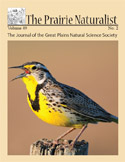Great Plains Natural Science Society
Date of this Version
8-2014
Document Type
Article
Citation
Proceedings of the 23rd North American Prairie Conference, August 2012, University of Manitoba in Winnipeg
The Prairie Naturalist 46: 29-39. August 2014
Abstract
When bison (Bos bison) repeatedly roll on the ground, they denude vegetation and create wallows (semi-permanent bare areas) that alter the native prairie plant community. Responses to these wallow-related disturbances are not as well documented in restored prairies. From 1 June to 1 September 2010 and from 3 June to 6 August 2011, we examined potential responses at Neal Smith National Wildlife Refuge, a restored prairie with resident bison. We hypothesized that plants and beetles would vary along a disturbance gradient. Our predictions were: (1) near wallows, plants with weedy lifestyles would have highest cover and biomass compared to plants with nonweedy lifestyles, (2) in control areas (i.e., nonwallows), weedy compared to nonweedy plant cover and biomass would not change over distance (measured from nonwallow locations with similar dimensions as their paired wallows), and (3) ground beetle abundance would increase further from wallows, but not change across distance at nonwallows. Results were varied. Indices of weedy to nonweedy plant cover and weedy to nonweedy biomass were highest adjacent to wallows, with no distance effect at nonwallows. Beetle abundance was affected by location but not distance, with more beetles trapped at nonwallows than wallows. Additionally, of the five common beetle genera, three were unequally distributed between wallows and nonwallows. Both plants and insects varied across wallows and nonwallows, but their responses along disturbance gradients likely occur at different scales.
Included in
Biodiversity Commons, Botany Commons, Ecology and Evolutionary Biology Commons, Natural Resources and Conservation Commons, Systems Biology Commons, Weed Science Commons


Comments
Published by the Great Plains Natural Science Society, 2014. Used by permission.